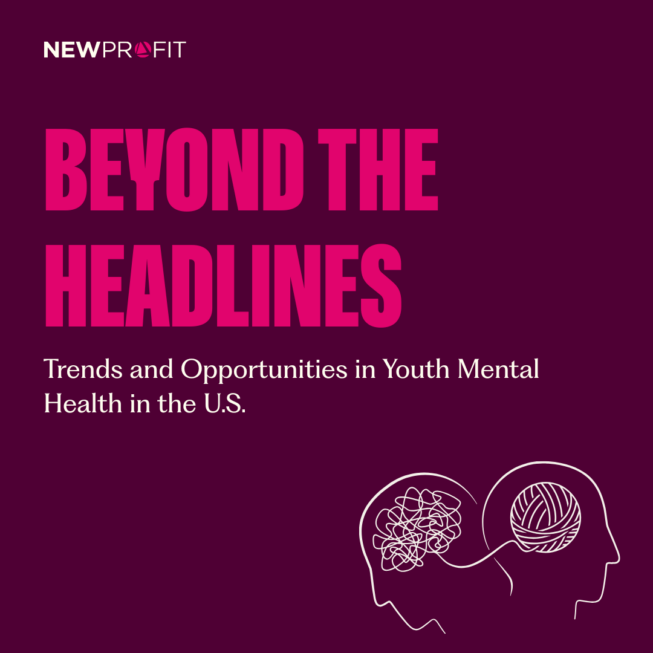Youth Mental Health: Cross‑Sector Coordinated Systems

In May, we published “Beyond the Headlines: A Deep Dive into Trends and Opportunities in Youth Mental Health,” a landscape analysis in partnership with human-centered design firm, People Rocket. This report provides a clearer picture of where funding is flowing, where the most pressing gaps remain, and how philanthropy can drive meaningful change in access and opportunity.
One of the key themes from the landscape analysis? No single program, clinic, or school can support young people alone. The most effective systems are the ones that work together.
With this in mind, we spoke with social entrepreneurs Reem Aly, Executive Director of the Ohio School‑Based Health Alliance, and Seth Saeugling, Co-Founder of the Rural Opportunity Institute based in North Carolina. They shared how they’re building more connected systems:
- Link systems, lighten the load: Coordination allows mental health support to follow youth, reducing friction and stigma.
- Shift blame to the system: When a youth struggles, it’s not the child–it’s the support network that’s broken.
- Embed youth wellbeing in every space: From “resilience walls” in schools to sheriff partnerships, mental health support is most effective when it’s part of the everyday environment.
Systems Are Only as Strong as Their Connections
The Beyond the Headlines landscape analysis surfaced a key reality: today’s youth mental health systems are fractured, and coordination is the glue.
Coordination That Keeps Students Connected to Care
Reem shared a vivid example of what happens–and doesn’t happen–when systems fail to talk to each other. “If you’re talking about kids with the greatest need,” she explained, “they’re facing other drivers of health… jumping from one district to another. When the child is getting a service, that provider doesn’t have all the information–past records, what the family has done, etc. Each one is trying to get that information from the family, but it’s hard and frustrating for the family to repeat themselves over and over again.” Unfortunately, that experience is common when information doesn’t move with the young person.
At the Ohio School‑Based Health Alliance, Reem’s team is shifting that reality. They work closely with schools and school-based health center operators to strengthen connections between school clinicians, community providers, and families. They aim to ensure a young person’s complete care plan follows them confidentially and seamlessly across settings.
When coordination works, students feel genuinely supported. In one northwest Ohio school, Reem shared how a school-based health center served as the coordinating hub for a student with undiagnosed ADHD. The center brought together the school nurse, teacher, family, and care team to clarify roles, develop a medication plan, and ensure the student was supported in class. “Once proper care management was in place,” she said, “the student didn’t have any more disciplinary issues and was doing better academically.”
Beyond supporting individual schools, Reem’s team is also advancing statewide systems coordination. Based on data collected by the organization in their annual census, Ohio’s school-based health center sites delivered more than 21,000 depression screenings and 20,000 well-child visits in the 2023-2024 school year alone. Through facilitation of a statewide learning community and targeted technical assistance, the Ohio Alliance supports school-based health centers in implementing universal depression screenings and integrated models of physical and behavioral health care. In partnership with state agencies, they are also working to expand the use of a pediatric psychiatric consultation line that connects primary care providers, including those in school-based settings, with one of eight Ohio hospitals to help diagnose and treat a range of pediatric mental health disorders that arise during visits. Reem sees these efforts as key to building a truly connected system of care, where data, providers, and school teams move in sync to support every student.
But when coordination breaks down, too many young people slip through the cracks.
Building a Network to Support a Proactive System of Care
In rural North Carolina, Rural Opportunity Institute (ROI) is a systems-change organization helping communities break cycles of generational trauma by expanding access to evidence-based trauma training in schools, increasing access to Medicaid-funded mental health care, and embedding practical tools like biofeedback breathing across institutions.
In Seth’s community, the shift began by building unlikely partnerships, including with the local superintendent and sheriff’s office, to replace punitive responses to students’ mental health challenges with real support. In a fragmented system, students who showed signs of distress might have been suspended, expelled, or pushed into the school-to-prison pipeline. With more coordinated support, those same students now receive care instead of discipline. Teachers, counselors, law enforcement, and ROI’s team work together on early interventions grounded in trauma awareness, emotional literacy, and resilience-building tools.

Seth described the current youth mental health landscape as a “patchwork quilt,” where disconnected systems mean young people often fall through the cracks. “The systems–or lack of systems–failed,” he said. “Pretty intense outcomes that will follow them through life.”
This groundwork of local partnership and early intervention has helped ROI build momentum for broader systems change. In partnership with North Carolina’s Department of Juvenile Justice and with support from the Duke Endowment, ROI is helping scale biofeedback breathing practices statewide. Their school-based Medicaid billing toolkit, first piloted locally, is now informing state-level reforms that aim to expand access to services for tens of thousands of students.
They’ve also helped a network of North Carolina school districts unlock significant new resources, recently increasing Medicaid-funded mental health dollars by over 200 percent, generating nearly $1 million in new funding. These dollars directly enabled schools to hire additional mental health staff and clinicians, expanding services to reach nearly three times as many students.
While these funding and policy wins reflect progress at scale, ROI’s roots remain in culture change. In some of the schools they support, students now participate in peer-led emotional learning groups and contribute to “resilience walls”–hallways where students anonymously share their stressors and affirmations. These types of supports go beyond crisis response by being embedded in everyday school life. The result is a culture where mental health isn’t just reactive, but relational and proactive–echoing the importance of supporting youth before a crisis point, as we explored in the first post in this series.
Mental Health is Healthcare
Reem and Seth both emphasized this truth: mental health is healthcare. When clinicians, counselors, teachers, and justice system partners work together, young people access services efficiently and experience safety and continuity.
Their stories highlight what coordination actually looks like in practice and what becomes possible when we move beyond siloed services. Together, they offer a vision of youth mental health that’s less fragmented and more relational.
- Missed Blog #1 or Blog #2? You can revisit the insights, voices, and solutions shared throughout the series. Thanks for reading, and for being in this work with us. With your help, we can shape what’s possible in youth mental health in the service of expanding access and opportunity. We hope these stories inspire new questions, deeper partnerships, and bold support for what comes next.
- Enjoyed this series? We’d love to hear from you. Reach out to Tezeta Tamrat, at [email protected] to share feedback or learn more.
- Interested in supporting social entrepreneurs driving impact in education? Contact our Investor Relations team at [email protected].
